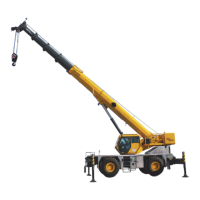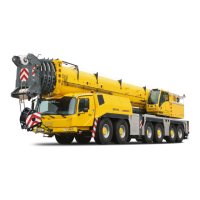CAPACITY CHART CD5515-2/YB5515-2 OPERATOR MANUAL
4-2 Published 1-20-2017, Control # 468-02
hoist rope, shall be considered as part of the load. The
weights for these items is stated on the capacity chart.
4. Rating on outriggers are for outriggers fully extended.
5. Ratings on rubber depend on tire capacity, condition of
the tires and proper inflation pressure of 8.96 bar (130
psi). Loads on rubber may be transported at a maximum
speed of 4 km/h (2.5 mph) on a smooth level surface
with the boom retracted to the shortest length possible
and centered over the front. Do not use the boom
extension with the crane on rubber.
6. For operating radius not shown on the Load Rating and
Range Diagram Chart, use load rating of the next larger
radius.
7. With a load both on the boom (pick and carry) and on the
crane’s deck the maximum combined load is 7258 kg
(16,000 lb). The maximum load that can be placed only
on the deck with nothing attached to the boom is 9070
kg (20,000 lb).
8. Do not induce any external side loads to the boom or the
boom extension.
Determining Lift Capacity at the Boom
Extension
The boom extension increases the length of the boom
assembly by 4.57 m (15 ft).
The capacity of the boom extension is determined in two (2)
steps. First, as with the main boom, check the main capacity
chart after determining the operating radius. These
capacities are based on main boom strength and machine
stability. Second, check the boom extension (jib boom)
structural capacities after determining boom angle. These
limits are based on the boom extension structural strength.
Use the lesser of these two capacities such that neither is
exceeded.
NOTE: Exceeding the capacity is dangerous and voids the
crane’s warranty.
Pick and Carry Ranges
Figure 4-2 illustrates the range of operation for pick and
carry loads. Do not pick and carry outside of the specified
ranges. The crane could become unstable and tip over.
Reference Only

